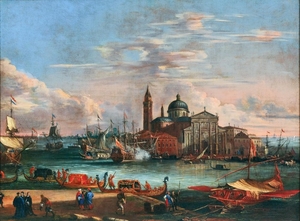Johann Anton Eismann
(Salzburg 1604–1698 Venice)
San Giorgio Maggiore, Venice,
oil on canvas, 108.5 x 145.5 cm, framed
We are grateful to Dario Succi for his help in cataloguing the present painting.
According to Succi the present painting is the only known view painting of Venice by Johann Anton Eismann, as such it is an extremely important addition to the artist’s corpus of works.
It is known that Eismann played an essential role in the diffusion of landscape painting in Venice during the last quarter of the seventeenth century, but his role in the genre of view-painting has been previously unknown. Eismann was registered in Venice in the fraglia (or guild) of painters from 1687 until 1700 and his works are well represented in the inventories of historic Venetian collections. His battle scenes often offer an expressly northern interpretation of Salvator Rosa’s poetic, while his celebrated seaports are enlivened by characteristic macchiette (or figures) that anticipate those in the paintings of Luca Carlevarijs (1663–1730).
It is known that Eismann collaborated with the much younger Carlevarijs and this is demonstrated by the presence in the celebrated Venetian collection of Field-Marshal Count Matthias von der Schulenburg of a pair of paintings described in his inventory of 30 May 1738 as follows: ‘Isman, e figure di Carlevari: due quadri compagni rappresentano vedute di mare con bastimenti e un castello’ [‘Isman, and figures by Carlevari: two paintings, a pair, representing sea views with bastions and a castle’].
Carlevarijs has been considered the pioneer in the genre of Venetian cityscape or vedute; his paintings were among the earliest Baroque depictions of the city. His celebrated engravings of Venetian views representing the principle places in the city were widely diffused and these images would greatly influence the later work of Canaletto and Francesco Guardi and the entire genre of painting which flourished in the 18th century. Eismann’s role and influence in the diffusion of this imagery needs to be studied further along with the present painting.
This composition represents the island of San Giorgio Maggiore, surrounded by a multitude of galleons, gondolas and other types of shipping. The church was designed in 1566 by Andrea Palladio and completed in 1610. The bell tower built on a square plan and terminating with a spire is represented according to its form prior to being redesigned in 1727. The foreground is animated by the sumptuous gondola d’oro (golden gondola) of a foreign ambassador with gondoliers dressed in red livery. In the foreground there are elegantly described figures of local dignitaries in their black robes, oriental merchants and porters.
The present painting is characterised by the lively rendering of atmosphere, its clarity of colour and brilliance of palette, in the striated sky. Echoes of Eismann’s depiction of atmosphere occasionally reoccur even in twentieth century painting as can be seen in the Venetian views of Giorgio De Chirico (see fig. 1).
View it on
Sale price
Estimate
Time, Location
Auction House
(Salzburg 1604–1698 Venice)
San Giorgio Maggiore, Venice,
oil on canvas, 108.5 x 145.5 cm, framed
We are grateful to Dario Succi for his help in cataloguing the present painting.
According to Succi the present painting is the only known view painting of Venice by Johann Anton Eismann, as such it is an extremely important addition to the artist’s corpus of works.
It is known that Eismann played an essential role in the diffusion of landscape painting in Venice during the last quarter of the seventeenth century, but his role in the genre of view-painting has been previously unknown. Eismann was registered in Venice in the fraglia (or guild) of painters from 1687 until 1700 and his works are well represented in the inventories of historic Venetian collections. His battle scenes often offer an expressly northern interpretation of Salvator Rosa’s poetic, while his celebrated seaports are enlivened by characteristic macchiette (or figures) that anticipate those in the paintings of Luca Carlevarijs (1663–1730).
It is known that Eismann collaborated with the much younger Carlevarijs and this is demonstrated by the presence in the celebrated Venetian collection of Field-Marshal Count Matthias von der Schulenburg of a pair of paintings described in his inventory of 30 May 1738 as follows: ‘Isman, e figure di Carlevari: due quadri compagni rappresentano vedute di mare con bastimenti e un castello’ [‘Isman, and figures by Carlevari: two paintings, a pair, representing sea views with bastions and a castle’].
Carlevarijs has been considered the pioneer in the genre of Venetian cityscape or vedute; his paintings were among the earliest Baroque depictions of the city. His celebrated engravings of Venetian views representing the principle places in the city were widely diffused and these images would greatly influence the later work of Canaletto and Francesco Guardi and the entire genre of painting which flourished in the 18th century. Eismann’s role and influence in the diffusion of this imagery needs to be studied further along with the present painting.
This composition represents the island of San Giorgio Maggiore, surrounded by a multitude of galleons, gondolas and other types of shipping. The church was designed in 1566 by Andrea Palladio and completed in 1610. The bell tower built on a square plan and terminating with a spire is represented according to its form prior to being redesigned in 1727. The foreground is animated by the sumptuous gondola d’oro (golden gondola) of a foreign ambassador with gondoliers dressed in red livery. In the foreground there are elegantly described figures of local dignitaries in their black robes, oriental merchants and porters.
The present painting is characterised by the lively rendering of atmosphere, its clarity of colour and brilliance of palette, in the striated sky. Echoes of Eismann’s depiction of atmosphere occasionally reoccur even in twentieth century painting as can be seen in the Venetian views of Giorgio De Chirico (see fig. 1).



